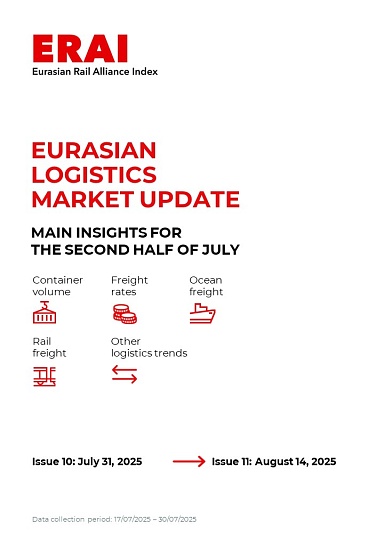When using, citing, or distributing the materials from this report, it is mandatory to reference the ERAI portal and include the webpage address https://index1520.com as the source of information.
China-Europe logistics market
Demand outlook
-
The 25th EU-China summit was held in Beijing. During the event, Chairman of the People’s Republic of China Xi Jinping called on the European Union to abandon sanctions and restrictions, emphasizing the importance of mutual respect, open cooperation, and multilateralism, while reaffirming commitment to strategic relations with Russia. In turn, European Commission President Ursula von der Leyen demanded that China reduce the trade imbalance, open its public procurement market to European companies, and ease export controls on rare earth metals—without offering any specific concessions from the EU. Participants of the China-EU summit adopted a final statement expressing the parties’ desire to accelerate the global advancement of renewable energy and facilitate developing countries’ access to «green» technologies. Additionally, following the summit, the sides signed a joint declaration on cooperation in climate change [Kommersant].
-
Preliminary July data shows Germany’s manufacturing PMI edging up to 49.2 (from 49.0 in June). While still below the 50-point expansion threshold, the upward trend suggests gradual sector stabilization. Output has now grown for five straight months, though the pace of growth has slowed to its weakest since February [Trading Economics].
-
The U.S. and EU have finalized a trade agreement that will see Washington impose 15% tariffs on most EU imports—including machinery—while Brussels eliminates duties on U.S. goods. As part of the deal, the EU will purchase $750 billion in U.S. energy supplies and invest $600 billion in the American economy. However, European economists warn of lingering risks, particularly for Germany, where manufacturing output could slump by up to 15%. Across the EU, production may contract by 11%, with exports likely taking a significant hit [RBC].
-
Shipping operators in Northern Europe are preparing for further delays and disruptions in August and September as a surge of Asian containers hits already strained ports. Soaring European import demand has kept vessels at full capacity, driving double-digit volume growth in recent months. With demand expected to remain strong through Q3, overwhelmed terminals face mounting pressure [JOC].
Freight rate trends
- The WCI Shanghai-Rotterdam rate has dropped by 3% over the past two weeks to $3 286/FEU (3% MoM, —57% YoY) [Drewry]. Rates have been easing steadily after peaking in late June/early July. Maersk slightly lowered its August bookings to $2 850/FEU, while OOCL, ONE, HMM, and Evergreen maintain offers between $3 100–3 500. COSCO, however, still quotes August rates above $4 000 [Linerlytica, GeekYum].
Other trends
-
Sea Legend Line (a subsidiary of Worldwide Logistics Holding) has announced plans to launch a China-Europe route via the Northern Sea Route (NSR) in autumn 2025. The container ship Istanbul Bridge with a capacity of 4 890 TEU will call at Qingdao, Shanghai, Ningbo, Felixstowe, Rotterdam, Hamburg, and Gdańsk. The company states that the transit from Ningbo to Felixstowe will take just 18 days [PortNews].
-
Polish train drivers, led by the ZZM union, are blocking roads in protest of what they call the government’s «anti-rail policies.» They demand transport reforms, citing discrimination against rail freight: high infrastructure fees have pushed cargo to trucks, worsening pollution and congestion. The protests coincide with the crisis at PKP Cargo, which is cutting 2 000 jobs after years of financial struggles and market losses [RailFreight].
China-EAEU logistics market
Import and export trends
-
The Board of Directors of the Bank of Russia on Friday, July 25, lowered the key rate by 200 basis points to 18% per annum. The Central Bank explained its decision by reduced inflationary pressure at a faster pace than previously forecast [Kommersant]. In addition to the rate decision, the Board of Directors also updated its medium-term forecast. Expectations for Russia’s GDP growth in 2025 remain in the range of 1-2%. The Central Bank’s expectations for the average key rate in 2025 were lowered to a range of 18.8- 19.6% from 19.5-21.5% (while from July 28 until the end of the year, the regulator expects the rate to be at 16.3-18%). Continued monetary policy easing will help boost export capacity.
-
Rates in the China-Moscow multimodal market are offered at around $3 600/FEU (SOC) and around $3 750/FEU (COC). Meanwhile, rates for rail services have increased significantly over the past two weeks (+$200) and stand at around $3 900/FEU.
-
KTZ and Russian Railways signed a protocol to improve operations at interstate border crossing points [Rail-news.kz]. This will allow for a 30% increase in the number of trains passing through interstate border crossings in the second half of 2025, from 65 to 85 pairs per day.
-
KTZ signed an agreement to attract a syndicated loan for the implementation of projects under the Trans-Kazakhstan Railway Corridor. The funds will be provided by Abu Dhabi Commercial Bank and Deutsche Bank. The loan amount is $604.8 million, with a term of 3 years [LogiStan]. The funds are planned to be used to finance projects of the Trans-Kazakhstan Railway Corridor, including the construction of the «Moyynty — Kyzylzhar» section, modernization of congested sections of Kazakhstan’s railway network, as well as refinancing loans of KTZ.
-
The Center for Transport and Logistics Development Studies under the Ministry of Transport of Uzbekistan, the Center for Research Initiatives «Ma’no» with the support of the PeaceNexus Foundation and the Embassy of Switzerland in Kyrgyzstan prepared a report on the prospects of the Middle (Trans-Caspian) Corridor. The document represents an attempt to compile a regional perspective on the prospects of this route. The research was conducted throughout 2024 and is based on 36 expert interviews and five focus groups with representatives of the transport and logistics industry in five countries, excluding Turkmenistan [1520international].



